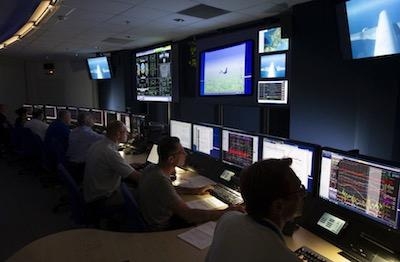Recent Upgrade Improves Data Collection And Analysis Capabilities At Toulouse
The vast amount of data produced by Airbus aircraft during development and certification flights is monitored at telemetry-gathering facilities, and the largest of Airbus’ sites – the Telemetry Center in Toulouse, France – recently underwent a major refurbishment that has opened up increased analytical opportunities.

Before an aircraft receives certification from airworthiness authorities, it must first go through a flight test campaign where its flight physics are closely monitored and crucial systems such as electrics, hydraulics, pressurisation and de-icing are rigorously studied. Throughout it all, telemetry – the science of collecting and transmitting data to a remote location – plays a vital role.
The French site is Airbus’ primary telemetry center and is connected to three others in Germany (in the cities of Hamburg and Bremen) and the United Kingdom (Filton). A crucial resource for the company’s flight test teams, the Telemetry Center in Toulouse monitors between four and six test flights a day and its trio of specially equipped rooms can cover up to three flights simultaneously. A typical test flight has between five and 20 specialists monitoring it, while as many as 80 might be involved in an aircraft’s first flight.
The steady pace of new Airbus jetliners keeps the Telemetry Center busy. “Currently we are working on the A330neo flight test campaign, and this summer, the BelugaXL, A330-800neo and the A319neo with Pratt & Whitney engines are all due to make their first flights,” said Guy Lacroix, a telemetry conductor. “We have to be highly reactive and flexible as the test schedules change frequently.”
During a test flight, an aircraft transmits a large amount of information to the ground via a radio frequency link. “We receive video from cameras inside the aircraft, data from its computers, and we are connected to a sound feed from the flight test team’s pilots and engineers,” said Lacroix. “We can be in constant communication with the crew.”
The use of telemetry enables flight test campaigns to be conducted quickly and efficiently as confirmation can be given in real time by the telemetry center that a test has been successfully completed, avoiding the need to re-perform a test flight. Telemetry also helps ensure the safety of test crews during flights.
Detailed analyses are also performed after each test flight, with the outcomes compared against computer models; these data are sent to the design office, aircraft program and other specialists to provide a global overview of the results.
Didier Martinez, who led the Toulouse Telemetry Center’s renovation, explained that the facility’s previous system, dating from 2004, had reached the end of its useful life. Now, 98-inch monitors – the largest on the market – provide experts with much more detailed images and purer colours. Touchscreen controls, combined with a simple interface, make the system easy to use and are paired with a state-of-the-art sound system. “We need to see exactly what’s going on during a test flight, so the information needs to be clearly and simply displayed,” said Martinez. “We want to feel like we are up there with those aboard the aircraft.”
(Image provided with Airbus news release)
 Aero-News: Quote of the Day (07.11.25)
Aero-News: Quote of the Day (07.11.25) ANN's Daily Aero-Term (07.11.25): Permanent Echo
ANN's Daily Aero-Term (07.11.25): Permanent Echo ANN's Daily Aero-Linx (07.11.25)
ANN's Daily Aero-Linx (07.11.25) NTSB Final Report: Schweizer SGS 2-33A
NTSB Final Report: Schweizer SGS 2-33A NTSB Prelim: Aeronca 7AC
NTSB Prelim: Aeronca 7AC



